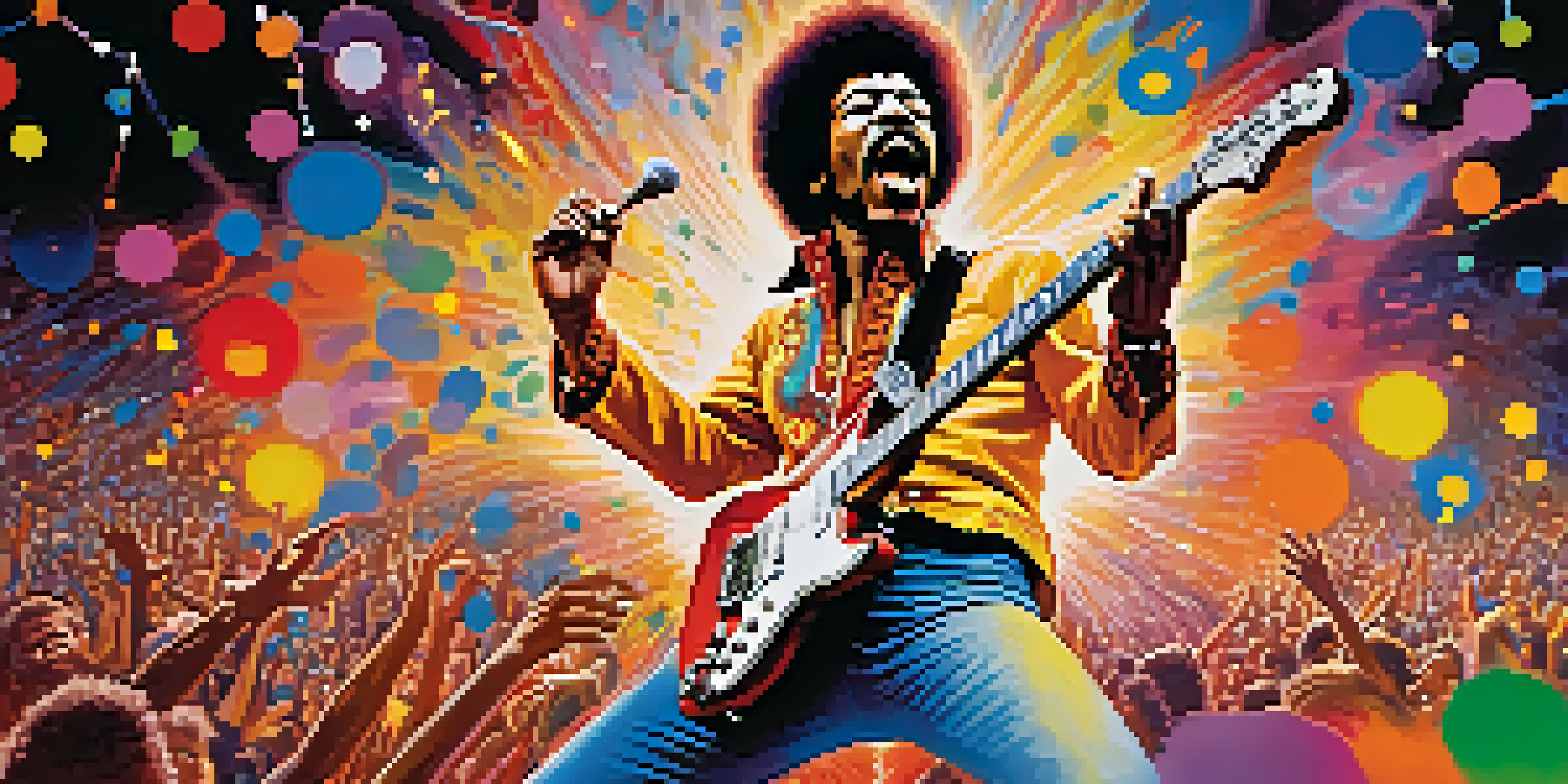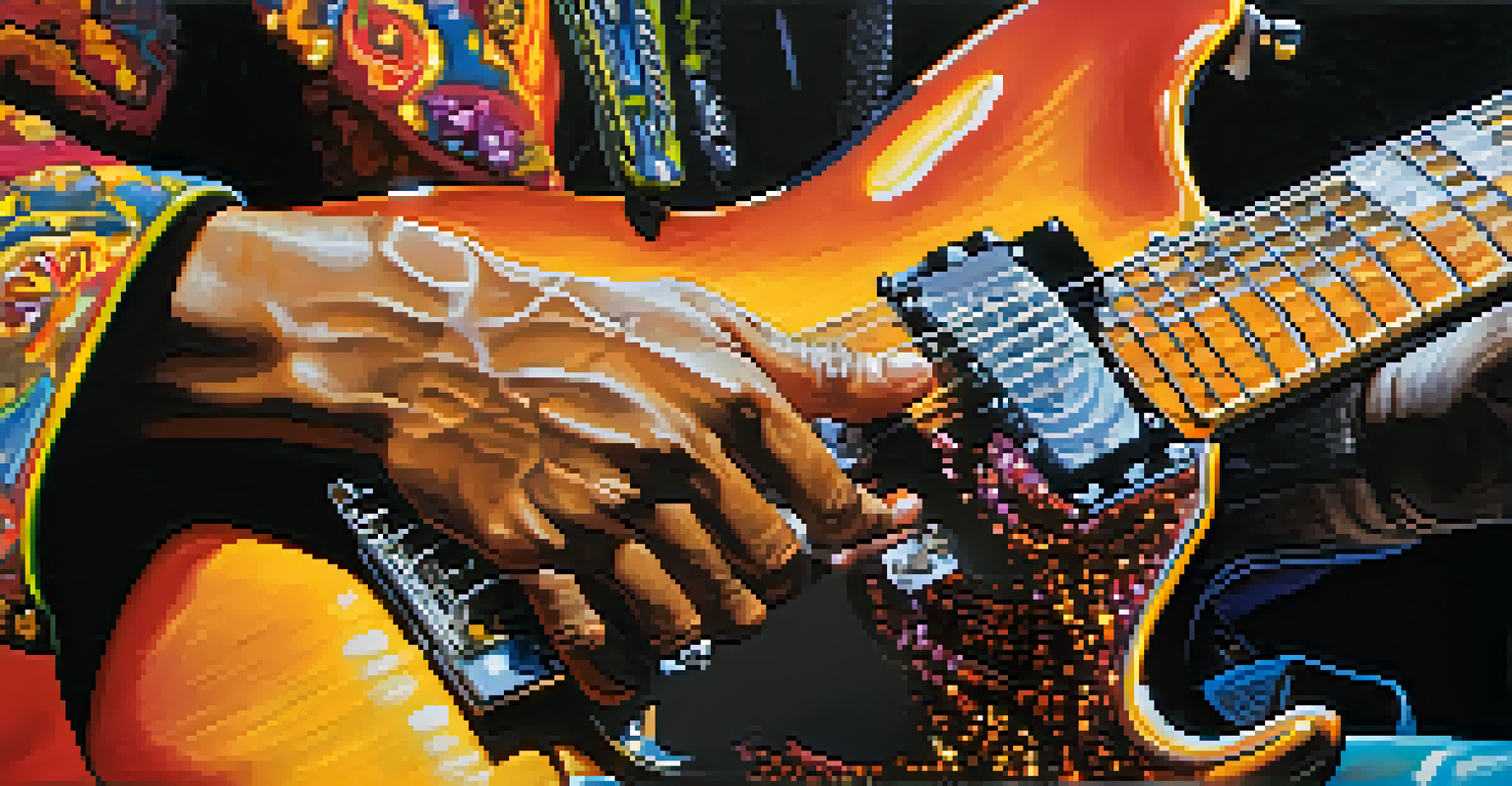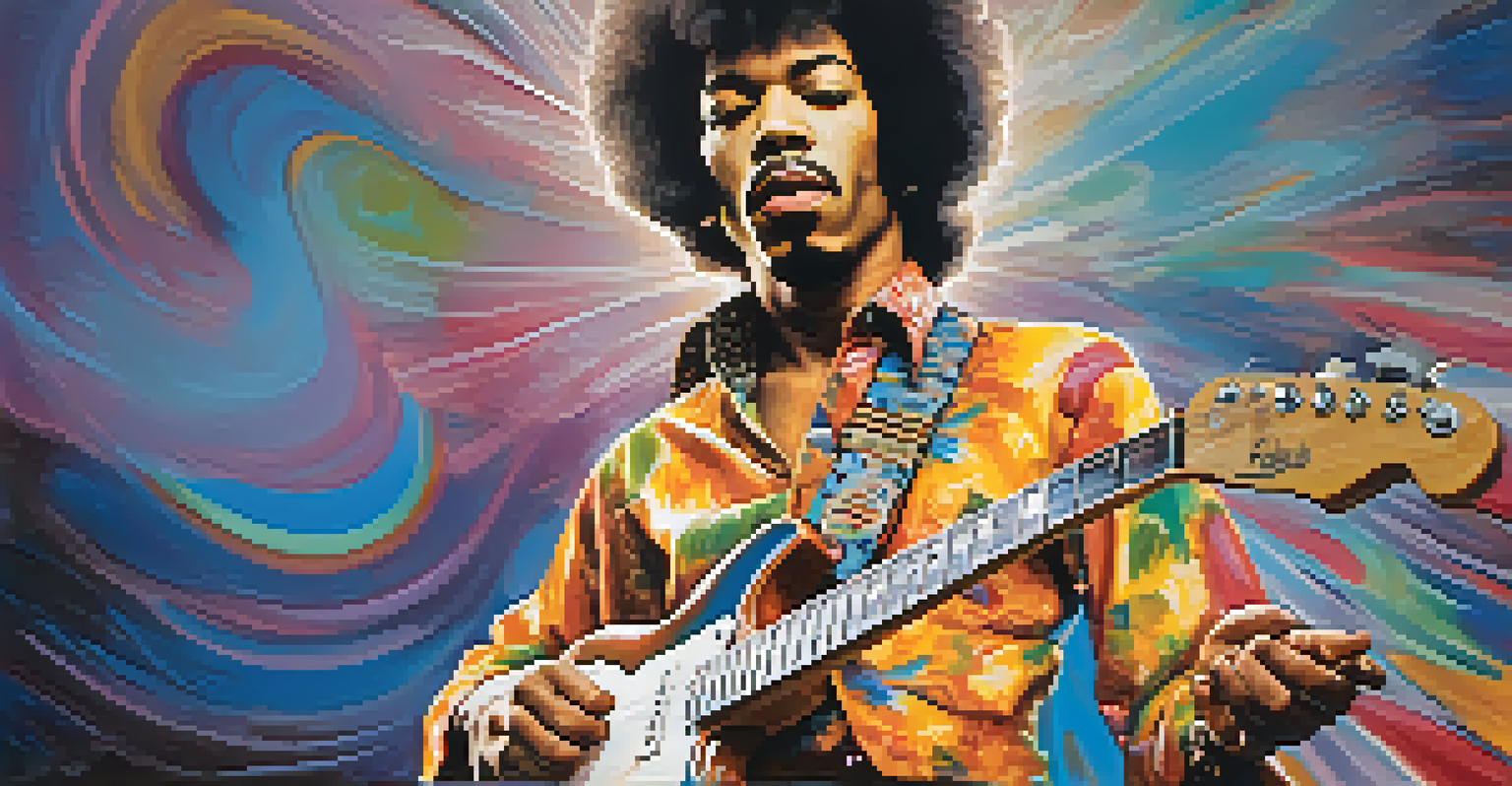Jimi Hendrix: Revolutionizing Electric Guitar Techniques

The Early Life of Jimi Hendrix and His Musical Roots
Jimi Hendrix was born in 1942 in Seattle, Washington, and grew up in a musically inclined family. His father, Al Hendrix, recognized his son's talent early on, often encouraging him to play the guitar. Jimi's initial influences included blues legends like B.B. King and Muddy Waters, who shaped his unique sound. These formative years set the stage for his revolutionary approach to guitar playing.
The guitar is a remarkable instrument, but it is the player that makes it sing.
As a teenager, Hendrix immersed himself in the vibrant music scene of the 1950s and 60s, experimenting with various styles. He started off playing in local bands, honing his skills and developing a flair for showmanship. His desire to stand out led him to adopt unconventional techniques, which would later become his signature. This early exploration laid the groundwork for the iconic performances that would captivate audiences worldwide.
By the time he moved to London in 1966, Jimi was poised to make a significant impact on the music industry. It was there that he formed the Jimi Hendrix Experience, which would propel him to international fame. His unique blend of rock, blues, and psychedelia not only showcased his talent but also redefined what the electric guitar could do, setting the stage for his legendary career.
Hendrix's Unique Approach to Guitar Playing
Jimi Hendrix is often celebrated for his innovative guitar techniques, which included the use of feedback, distortion, and unique tunings. He wasn’t afraid to experiment, pushing the boundaries of what was considered conventional. For him, the electric guitar was not just an instrument; it was an extension of his creativity and emotions. His fearless experimentation opened up new possibilities for guitarists everywhere.

One of Hendrix's most notable techniques was his use of the whammy bar, which allowed him to create dramatic pitch bends and dive bombs. This technique added a new dimension to his music, giving it an expressive quality that resonated deeply with listeners. His ability to manipulate sound through the guitar set him apart from his contemporaries, making every performance a unique experience.
Hendrix's Innovative Guitar Techniques
Jimi Hendrix revolutionized guitar playing with his unique techniques, including feedback, distortion, and unconventional tunings.
Additionally, Hendrix's use of chord voicings and fingerpicking techniques created a rich harmonic palette. He often employed unconventional chord shapes and intervals, which contributed to his distinctive sound. This approach not only influenced rock music but also inspired countless guitarists to explore their own unique styles, resulting in a ripple effect throughout the music world.
The Role of Feedback and Distortion in His Sound
Feedback and distortion are often associated with rock music, but Hendrix was among the first to harness their full potential. He famously used feedback as a musical tool rather than a mere byproduct of amplification. By strategically positioning himself in front of speakers, he could create swirling soundscapes that added depth to his performances. This innovative use of technology transformed how musicians approached live sound.
I’m a creative person, and I want to make music that has feeling and meaning.
Distortion, too, became a hallmark of Hendrix's style. He utilized fuzz pedals and overdrives to enhance his guitar tone, creating a raw, powerful sound that captured the essence of his music. Songs like 'Purple Haze' and 'Foxy Lady' showcased this signature tone, making them instantly recognizable. His fearless approach to distortion influenced generations of rock guitarists who sought to emulate his powerful sound.
The combination of feedback and distortion not only defined Hendrix's music but also revolutionized the electric guitar landscape. It paved the way for future artists to experiment with sound in ways never thought possible. This legacy continues to inspire musicians across genres, demonstrating the lasting impact of Hendrix's pioneering approach.
Innovative Techniques: The Wah-Wah Pedal and Beyond
One of the standout elements of Hendrix's guitar playing was his creative use of effects pedals, particularly the wah-wah pedal. This pedal allowed him to manipulate the tone and frequency of his guitar, creating a vocal-like quality in his solos. Songs like 'Voodoo Child (Slight Return)' exemplify how effectively he used this tool, adding a dynamic layer to his performances.
Hendrix's experimentation didn't stop at the wah-wah pedal; he also used various other effects such as phasers, flangers, and octavers. Each effect contributed to his distinctive sound, allowing him to craft a sonic landscape that was both complex and engaging. His willingness to explore uncharted territory with effects paved the way for future musicians to delve into new creative avenues.
The Impact of Blues on His Style
Hendrix skillfully blended blues influences into his rock music, creating a sound that resonated with a wide audience.
By incorporating these innovative techniques into his music, Hendrix not only showcased his exceptional skill but also redefined the role of effects in rock guitar. His pioneering spirit encouraged countless guitarists to embrace technology and experiment with their sound. This legacy continues to influence modern music, reminding us that creativity knows no bounds.
The Influence of Blues on Hendrix's Guitar Style
At the heart of Jimi Hendrix's music lies a deep-rooted connection to the blues. His guitar playing was heavily influenced by the expressive techniques of blues legends, which he skillfully integrated into his own style. The emotional depth and storytelling inherent in blues music resonated with him, inspiring him to push the boundaries of the genre. This fusion of rock and blues became a defining characteristic of his sound.
Hendrix's ability to convey emotion through his guitar playing is perhaps best illustrated in songs like 'The Wind Cries Mary.' The soulful bends and intricate phrasing evoke a sense of longing and melancholy, showcasing his mastery of both the instrument and the genre. By infusing rock music with blues elements, he created a sound that was both familiar and groundbreaking, appealing to a wide audience.
Moreover, Hendrix's interpretation of the blues helped to reshape the genre itself. He took traditional blues motifs and infused them with his signature flair, introducing a new generation to the beauty of the music. His influence on blues and rock guitarists alike can still be felt today, as many continue to draw inspiration from his unique blend of styles.
Hendrix's Iconic Live Performances
When it comes to live performances, Jimi Hendrix was a force of nature. His stage presence was magnetic, captivating audiences with his energetic and often theatrical style. From playing his guitar behind his head to setting it on fire, every performance was a spectacle that left a lasting impression. This showmanship complemented his musical prowess, creating an unforgettable experience for concertgoers.
Hendrix's ability to connect with his audience was unparalleled. He often improvised during performances, adding spontaneity and excitement to his shows. This unpredictability kept fans on the edge of their seats, never knowing what to expect next. His improvisational skills not only showcased his technical abilities but also highlighted his creative spirit, making each performance unique.
Legacy of Iconic Live Performances
Hendrix's magnetic stage presence and improvisational skills transformed live performances, inspiring future generations of musicians.
The legacy of Hendrix's live performances continues to resonate with musicians today. His innovative approach to showmanship and musicianship has inspired countless artists to push the boundaries of their own performances. Through his unforgettable concerts, he demonstrated that music is not just about sound; it's also about the energy and connection shared between the artist and the audience.
The Lasting Impact of Jimi Hendrix on Music
Jimi Hendrix's influence extends far beyond his own era, shaping the landscape of music for decades to come. His revolutionary techniques and distinct sound set a new standard for electric guitar playing, inspiring countless musicians across various genres. From rock to funk and even hip-hop, his innovative approach to music can be heard in the works of artists who followed in his footsteps.
Many guitarists credit Hendrix as a significant inspiration in their own musical journeys. Icons like Eric Clapton, Stevie Ray Vaughan, and Prince have all acknowledged the impact of Hendrix's techniques and style on their work. His ability to blend genres and push creative boundaries encouraged musicians to explore their own unique sounds, resulting in a rich tapestry of musical evolution.

Today, Hendrix's legacy continues to thrive through tributes, cover bands, and guitarists who emulate his techniques. His music remains timeless, resonating with new audiences and inspiring future generations of musicians. Jimi Hendrix revolutionized the electric guitar, and his influence will endure as long as music exists.